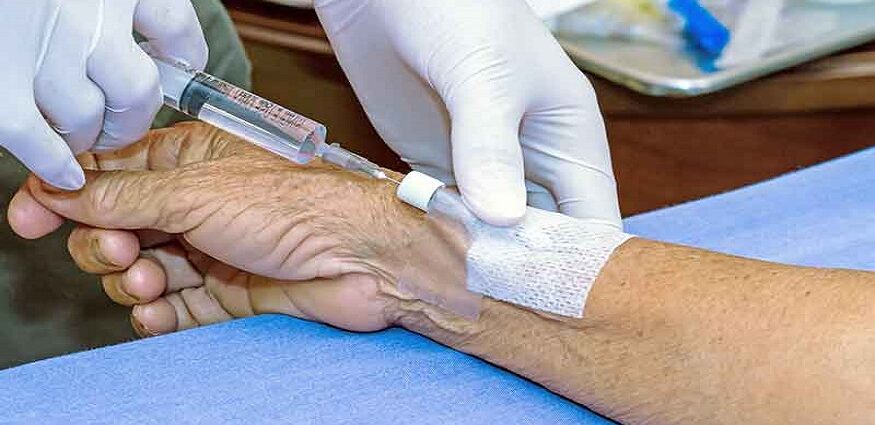Propofol Injection-Induced Pain
Propofol is a widely used intravenous agent for anaesthetic induction and maintenance. However, injection pain is close to 70% if no prior treatment is performed. It is described as a sharp stinging, or burning pain.
So far, the mechanism by which propofol induces injection pain remains unclear. As a drug, it belongs to the group of phenols that can directly irritate the skin, mucous membrane, and intimal layer of the vein with immediate stimulation of nociceptors and involvement of the kallikrein-kinin or bradykinin system. Other hypotheses are also considered, such as the intrinsic properties of the drug (emulsion, pH of the formulation, temperature, volume and osmolarity) or the displacement speed of the plunger during injection, the concentration of free propofol during the aqueous phase, or the use of local anaesthetics among others.
A study recently published in the European Journal of Anesthesiology examines the effect of the menstrual cycle on propofol injection pain. Seventy-two patients scheduled for elective surgery under general anaesthesia were divided into two groups according to the phase of their menstrual cycle (follicular phase or luteal phase). Injection pain was assessed on a numerical scale from 0 to 10 after injecting 25% of total propofol in 20 seconds. The conclusion is that the pain perception upon propofol injection is more significant in the luteal phase. For practical purposes, we would consider that the stages of the menstrual cycle play an essential role in the perception of pain due to propofol in females.
In the pediatric field, it has been observed that the child sitting on his mother’s lap during induction significantly reduces injection pain. The curious thing about the study is that the perception of pain increases with age, as the child no longer has such a dependent maternal bond.
The incidence and severity of propofol-induced pain are directly related to the injection site or vessel calibre. In this sense, the incidence varies from 10% in the antecubital fossa to 90% in the back of the hand.
Strategies to reduce injection pain
Exceptional documents by Elisabeth Liljeroth from Lund University (Sweden) and Pascale Picard from Geneva University Hospital (Switzerland) for their scientific interest, but also for their very complete and well-argued content. The first belongs to a doctoral thesis. We briefly summarise part of these files.
Thiopental
The reason thiopental prevents injection pain is not entirely clear. Still, several mechanisms appear to be involved: its physical properties, such as alkalinity and lipid solubility, can modify the concentration of free propofol at the injection site. Co-administration of subanesthetic doses may inhibit pain perception. Finally, thiopental appears to block the release of bradykinin, which causes vasodilation and hyperpermeability.
Ketamine
Its co-administration blocks NMDA receptors as a plausible explanation for its action.
opiates
Alfentanil does not ameliorate injection pain through the action of peripheral opioid receptors. Fentanyl does not appear to be effective in this regard. Tramadol is considered as effective as lidocaine.
During the administration of propofol and remifentanil through TCI infusion systems, a significant reduction in propofol injection pain was observed when remifentanil infusion was first started at an adequate concentration of 4 ng ml.
MATERIAL
Its efficacy in this aspect is somewhat controversial if we consider that NSAIDs can cause pain during their administration. However, we could explain its mechanism of action by inhibiting prostaglandin synthesis and the kinin cascade. Flurbiprofen or ketorolac are two of the drugs that have given the best results.
Local anaesthetics
Lidocaine is the most widely used local anaesthetic to reduce propofol-induced pain. It can be mixed with propofol or separately, although clinical studies advocate mixing the two drugs. One possible explanation would be that lidocaine would release hydrogen ions when combined with the lipids contained in the propofol formulation. Reducing the pH of lidocaine would reduce the free concentration of propofol and reduce pain at the puncture site.
Other drugs
Within the armamentarium of drugs that have been tested to prevent pain on propofol injection, dexamethasone stands out at antiemetic doses, kallikrein inhibitors such as nafamostat mesylate, sympathomimetics such as ephedrine at low doses of 30-70 mcg/ Kg before propofol injection, prior administration of a beta-adrenergic inhibitor such as metoprolol, metoclopramide-type antiemetics. Other possible drugs would be magnesium sulfate or protoxide.
Strategies related to the composition of propofol
propofol formula
To modify the lipid composition of propofol, cool the propofol formulation to a temperature of 4°C to locally inhibit the kallikrein-quinine system. Adopting the opposite position, that is, heating the propofol formulation before its administration to reduce the free concentration of the drug. However, with this system, we increase the probability of bacterial contamination. In a meta-analysis, neither of the two techniques (cooling or heating) has achieved conclusive results.
Acidifying its formula, diluting or mixing it with blood, or using filters during its intravenous administration, are other techniques used to reduce injection pain.

